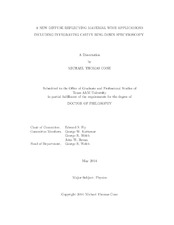A New Diffuse Reflecting Material with Applications Including Integrating Cavity Ring-Down Spectroscopy
Abstract
We report the development of a new diffuse reflecting material with measured
diffuse reflectivity values as high as 0.9992 at 532 nm, and 0.9969 at 266 nm. These
values are, to the author’s best knowledge, the highest diffuse reflectivity values
ever produced. The material is a high-purity fumed silica, or quartz powder. We
demonstrate the application of this new material to several areas of integrating cavity
enhanced spectroscopy, including absorption, Raman, and fluorescence spectroscopy.
In addition, we demonstrate a new spectroscopic technique based on cavity ring-down
spectroscopy using an integrating cavity made of our new diffuse reflector.
This technique, which we call integrating cavity ring-down spectroscopy (ICRDS),
has tremendous potential for sensitive absorption measurements of low-absorbing
samples, even when there is strong scattering. Results for measurements of the
absorption coefficient of retinal pigment epithelium cells using this ICRDS technique
are also presented. Finally, we discuss the importance of the “wall-time” when
considering the temporal response of an integrating cavity. Light reflecting off the
inner wall of an integrating cavity actually penetrates into the diffuse reflecting
material. Therefore, the light spends some time inside the cavity wall. We measure
this wall-time via two independent methods, and show that it can be on the order
of several picoseconds.
Citation
Cone, Michael Thomas (2014). A New Diffuse Reflecting Material with Applications Including Integrating Cavity Ring-Down Spectroscopy. Doctoral dissertation, Texas A & M University. Available electronically from https : / /hdl .handle .net /1969 .1 /152759.


